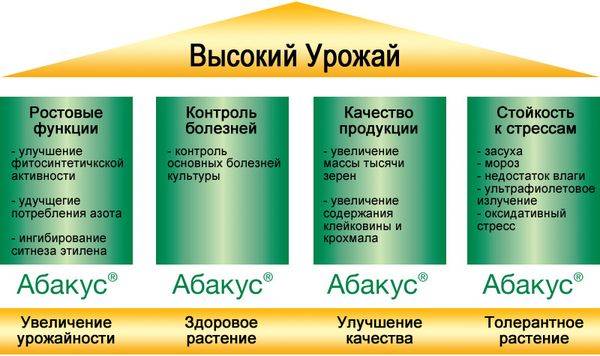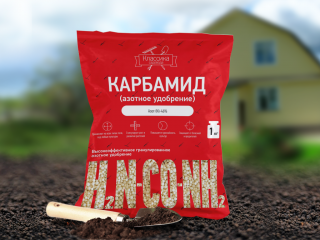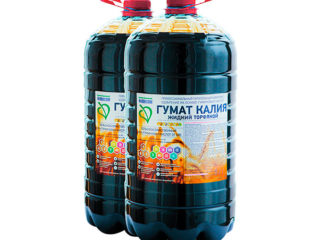Content
Among the large line of fungicides produced by the flagship chemical company BASF, Abacus Ultra has become one of the best means for preventing diseases of grain crops caused by fungi.
Composition, mechanism of action
The active ingredients of the fungicide are pyraclostrobin and epoxiconazole. Their concentration is 62.5 g/l. The effect of their use is maximum.
- Pyraclostrobin belongs to the class of strobilurins. It has a systemic effect on plants. In fungal organisms, when it is used, the conductivity of mitochondria is disrupted, which is why the cells are no longer supplied with energy. Both the spores and the mycelium of the fungus die. Pyraclostrobin is able to bind to the wax coating on the leaves of grain crops; it moves into the plant from the treated surface gradually. Its main function is to prevent pathogens from penetrating into the leaf apparatus.
- Epoxiconazole belongs to the triazole class and has a translaminar effect. It disrupts the synthesis of ergosterol in fungal microorganisms. Epoxiconazole is absorbed quickly by plants and, spreading through the vessels, provides their internal protection.
The combined effect of these two fungicides is diverse and is not limited to the protective function.
The biofungicide increases the density of chlorophyll in the leaf apparatus of plants and somatically enhances photosynthesis. By binding carbon dioxide, plants produce carbohydrates more intensively, starch accumulates, and grain yield increases.
This becomes possible due to an increase in the weight of 1000 grains due to an increase in the amount of starch and protein.
Abacus Ultra is a fungicide that improves the stress resistance of grain crops. This is explained by an increase in the amount of growth hormones with a decrease in the effect of oxidative compounds on plants. Because stress causes them to release ethylene, which is an aging hormone, the ripening phase of grains occurs faster, which prevents them from growing fully. Thanks to Abacus Ultra, the formation of ethylene is inhibited, the plants spend all their energy on forming a full-fledged harvest, their aging slows down, and the leaves do not turn yellow longer. Active chlorophyll allows you to produce more carbohydrates and better absorb nitrogen.
Cytokines, abscisic acid, and other growth hormones under the influence of the Abacus Ultra fungicide are found in grain crops in optimal quantities.
The fungicide reduces sunspots on barley leaves that appear in late spring due to bright sun after rain. Because of them, tissues die and plants age prematurely, which reduces yield. Abacus Ultra prevents this.
A high grain yield is possible only if their leaf apparatus is healthy. If the top four leaves: third, fourth, subflag and flag are not diseased and function correctly, this increases the maximum yield by 80%.It is during the development of these leaves that the peak incidence of fungal diseases occurs. Therefore, it is so important to warn them and ensure the photosynthesis process is 100%.
On average, it is about 7.8 c/ha, the weight of each 1000 grains increases by 6.3 g.
The contribution of various vegetative organs to the total yield can be presented in the form of a table.
Vegetative organ | Yield increase |
Third sheet | 7% |
Fourth sheet | 2,5% |
Fifth sheet | 0% |
Sub-flag sheet | 23% |
Flag sheet | 42,5% |
Ear | 21% |
How and when to treat
If you read the instructions for using the fungicide, it becomes clear that it is effective in preventing many diseases caused by fungi: various spots, powdery mildew, pyrenophorosis, rust: brown and stem, septoria, which appears on the ear and leaves, rhynchosporiasis. Features of using Abacus Ultra to prevent these diseases in various crops:
- grains are treated with a fungicide once at the first manifestations of the disease, using from 25 to 300 liters of the diluted drug per hectare, depending on the type of plant and method of treatment;
- beets and corn are treated with fungicide up to 3 times - prophylactically at the beginning of the growing season and twice when the disease manifests itself, the interval between spraying is from 2 to 3 weeks, about 300 liters of working solution are used for each hectare.
The waiting time for grains is 4 decades, for other crops - 5 decades. Terms of use of the drug for various diseases at different stages of the growing season of cereals.
To prepare a working solution, dilute 1 and 3/4 liters of the drug in 300 liters of clean water. It is produced in the form of a suspension emulsion. The volume of the plastic canister with fungicide is 10 liters.
Hazard class and precautions
Abacus Ultra is considered a slightly toxic fungicide and has a hazard class of 3. It does not pose a threat to humans and animals, and is slightly dangerous to bees, which is why spraying during flowering and summer of bees is prohibited.
Despite the mild toxicity, safety precautions must be observed when working with the drug.
- Use personal protective equipment to protect your eyes and respiratory system.
- Prepare the drug only in clean containers.
- Do not keep them near food.
- Do not dispose of drug residues with household waste.
If the drug accidentally gets on the skin, wash it off with soapy water. In case of contact with eyes, rinse them for at least 15 minutes with clean water. If, if safety precautions are not followed, particles of the drug get inside, you should drink activated carbon and seek medical help.
Advantages of the drug
The fungicide has the AgCelenc effect: it protects and heals at the same time. The drug has advantages over long-used fungicides.
- Protects crops from almost all diseases caused by fungal pathogens.
- Optimizes the vital state of plants.
- It is an excellent anti-stress agent, increases the resistance of plants to the effects of any negative factors.
- Increases the efficiency of photosynthesis.
- Enhances the removal of nitrogen from the soil and its absorption by plants.
- Improves the characteristics of grain and its sowing qualities.
- Increases yield and grain weight.
You can watch the video for more details about the drug:
Abacus Ultra is not cheap, but its use is quite justified, especially if the crop area is large. The cost of the drug is recouped by healthy plants throughout the growing season and an excellent harvest. Reviews from those who have used it are extremely positive.
















